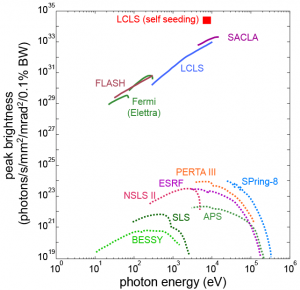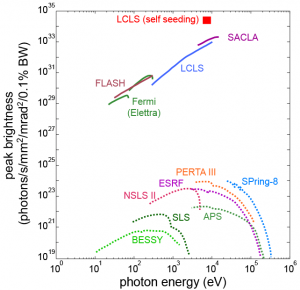Record Peak Brightness
We developed and applied record peak brightness X rays at the Linac Coherent Light Source (LCLS) to resolve ionic interactions at atomic (Ångstrom) scale lengths and to determine the physical properties of matter in extreme conditions. Our in situmeasurements characterize the compressed lattice and resolve the phase transitions demonstrating that we obtain accurate structure factor and equation of state data. In addition, the unique properties of the x-ray laser provide plasmon spectra that yield temperature and density with unprecedented precision at micron-scale resolution in dynamic compression experiments.

The initial proposal for hard x-ray self-seeding at LCLS was described by Amann et al. (2012). The forward Bragg scattered beam consists of a ‘prompt’ transmitted beam and a delayed monochromatic wake generated from the wings of the Bragg diffraction profile. The diamond (400) reflection was chosen as the wake monochromator for suitable crystal perfection, angular width and low absorption. The approach to self-seeding matched the electron bunch duration of approximately 10 fs (20 pC) to the width of the first wake maxima. The operational phase, following commissioning of self-seeded operation, has shown that the normal operation of hard x-ray self-seeding performs better with the nominal 150 pC charge and the corresponding 50 fs pulse duration. The stability is improved by roughly a factor of two compared to the low charge operation with a similar reduction in the per pulse energy fluctuations. In this mode the pulse energy of the seeded beam is significantly improved with the longer pulse (higher charge) mode. The seeded beam normally gives a 2 to 4 times improvement in time average x-ray power compared with a post-monochromator of similar bandwidth with similar pulse durations and shot-to-shot intensity fluctuations. The narrow seeded line, 0.4 eV to 1.1 eV full-width at half maximum, for a 50 fs pulse duration typically contains an average pulse energy of 0.3 mJ, with occasional shots up to 1 mJ. The peak brightness of 2.7x1034 photons/s/mm2/mrad2 0.1% BW is calculated from the measured pulse duration and a mean pulse energy of 0.3 mJ.
References
Demonstration of self-seeding in a hard-X-ray free-electron laser. Nature Photonics 6, 693 – 698 (2012).
Ultrabright X-ray laser scattering for dynamic warm dense matter physics. Nature Photonics 9, 274-279 (2015).

